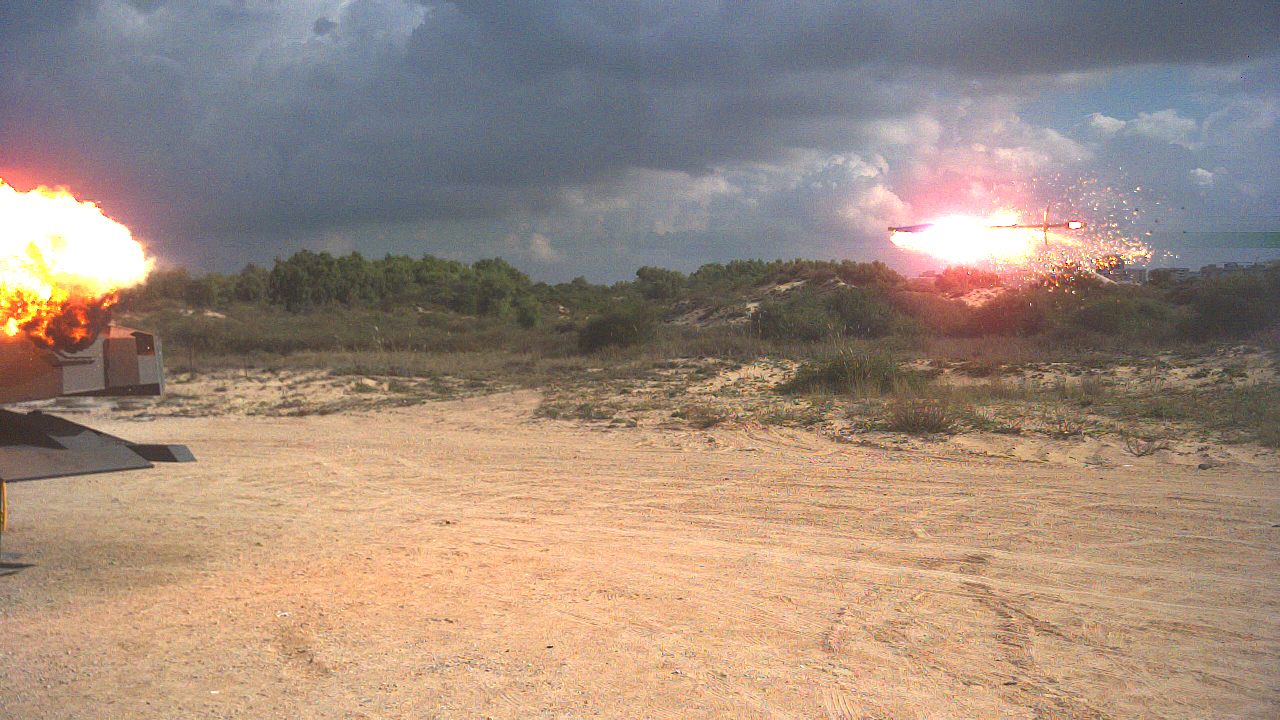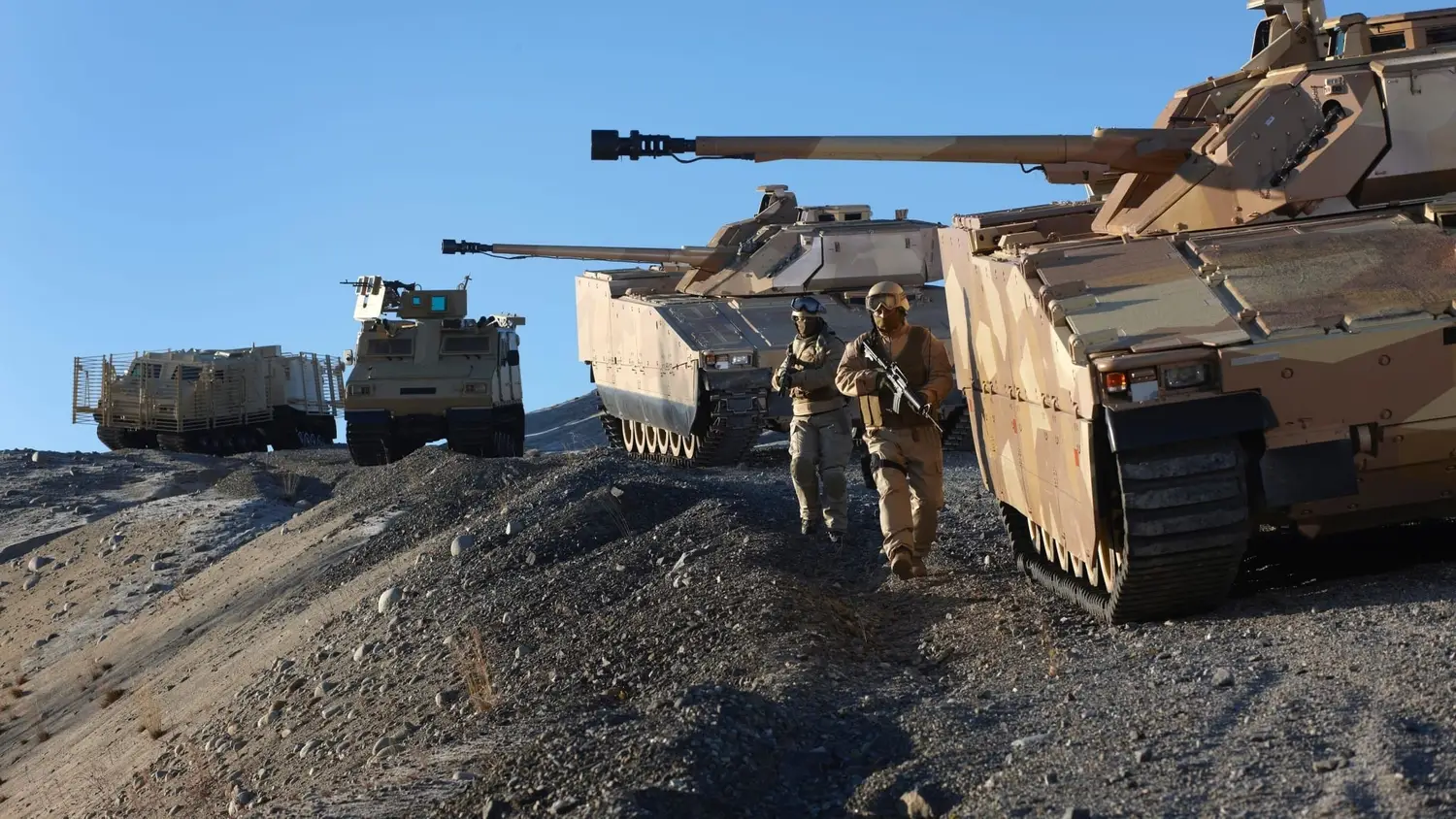
REPORT HOME > Staying ahead
september 2023 | technology report | armoured vehicles
Vehicle self-protection suites are no exception to the ongoing struggle between threat and countermeasure. How can the latest technology help such systems stay relevant against peer adversaries with advanced and ever-evolving offensive capabilities?
Above: The widespread availability of low-cost anti-armour munitions and the increasing threat from UAS is driving the need for all front-line vehicles to have APS, according to Leonardo UK. (Image: Leonardo)
There are a wide range of self-protection systems on the market for armoured vehicles, using both soft-kill and hard-kill approaches. The lessons of recent conflicts have sparked a growing focus on the technology, notably adapting to the threat posed by UAVs.
The systems are a focus for the UK’s Defence Science and Technology Laboratory (Dstl) through its Modular Integrated Demonstrator Programme (MIPS), which is being developed by a Leonardo UK-led team.
Launched in 2017, MIPS comprises a range of sensors and countermeasures designed to detect and disrupt threats to combat vehicles, as well as robotic and autonomous systems.
‘The boundary between self-protection systems and situational awareness systems is increasingly blurred.’
The MIPS architecture was demonstrated in July 2021 through the Icarus Technology Demonstrator Programme (TDP). Tom Newbery, Dstl land survivability technical lead, said the agency and its industry partners are now moving forward with the next phase of MIPS development, which involves implementing two spirals of capability geared towards the defeat of priority threats.
‘As well as maturing the core architecture, this is also demonstrating that MIPS can be applied to a real-world, fully functional family of survivability suite capabilities,’ he said.
In the longer term, this will enable integration across architectures and technologies, such as the radio frequency (RF) work being conducted under the Bright Corvus umbrella and the systemic protection work carried out by the British Army’s Project Mercury.
Right time, right place
The major focus is ensuring that the army has effective survivability at the right time and place, Newbery said. The goal is to use open architectures to enable survivability suite developments in a cost-effective and rapid way, and to improve integration with mission systems.
‘However, MIPS is just one part of the puzzle,’ he added. ‘We also need the key technologies (the sensors and effectors, the smart algorithms and the crew interfaces) that will exploit MIPS to provide the game-changing capabilities we need.’
Newbery noted that while it is important to avoid focusing too heavily on a single scenario, the war in Ukraine has underlined rapid developments in the use of UAS, which is likely to be a core focus for self-protection systems in the years ahead.
‘We need to know what the options are for responding to this, both directly and also [in terms of] indirect effects, in how ubiquitous UAS change the battlespace,’ he said. This reinforces the need to be on the front foot when it comes to capability development.
‘We don’t know exactly what threat we’ll face, nor how that will be employed, but what we can say with certainty is that it will develop and respond to our actions. This means the one thing we can be sure of is the need for adaptability, hence our focus on the use of open architectures for survivability suites.’
Newbery emphasised the need for the technology to adapt into the future, with MIPS built on an architectural blueprint that allows the system to swap in and out new equipment, such as sensors or effectors, as well as more subtle changes to algorithms, processing technologies or threat libraries.
‘What I think is becoming recognised is that the boundary between self-protection systems and situational awareness systems is increasingly blurred,’ Newbery added. ’Our greatest asset is the crew in the vehicle, and one of the most important functions of any survivability suite is providing that crew (and those networked with them) with real-time information on the battlefield around them, to help cut through the fog of war and let them do their job most effectively.’
Low-cost threats
David Hawkins, MIPS campaign director at Leonardo UK, noted that the widespread availability of low-cost anti-armour munitions and the increasing threat from UAS is driving the need for more front-line vehicles to have active protection systems (APS).
‘The rapid evolution of these threats also highlights the need for vehicle protection systems to be able to be quickly reconfigured or updated in in order to provide effective countermeasures, which is where the dependable open-systems architecture approaches such as MIPS provide a key advantage over conventional, off-the-shelf APS,’ he said.
Radar sensors that are optimised for detecting, tracking and intercepting missile and rocket threats are a key part of APS, he said. However, the growing threat from drones and small UAS means self-protection radar systems have had to evolve.
‘Passive optical sensor technology is also being used in conjunction with the radars to carry out the initial detection of potential threats from missiles and targeting systems, allowing the active radar sensors to remain in a dormant state until they are alerted by the passive sensors, which limits any active vehicle signature and reduces the likelihood of detection and potential attack,’ said Hawkins.
Above: Rafael, manufacturer of the widely used Trophy APS, aims to develop both the system’s sensors and the countermeasures it deploys to deal with new threats such as UAS. (Image: Rafael)
Niv Cohen, head of the land manoeuvre division at Rafael, manufacturer of the combat-proven Trophy APS, also pointed to the growing threat from UAS, which has demanded advances in both hardware and software.
Cohen said the company is focused on advancing both the sensing system and the interceptors/countermeasures that underpin Trophy. In particular, he said there is now an emphasis on situational awareness for the vehicle overall, so not just focused on threats.
‘It’s hard to say what the threats will be,’ he said. ‘But we need to ensure that our countermeasure is robust enough that we will be able to deal with any threats in the next five, ten, fifteen years.’
Reliable detection
Hensoldt’s MUSS system is designed to protect vehicles against antitank guided missiles (ATGMs), laser-guided munitions and beyond. In the company’s view, such threats have grown more versatile, ubiquitous and overwhelming, as shown by the widespread use of UAVs and artillery in the Ukrainian conflict.
In response, the company’s self-protection solutions have been refined to counter more threats, with an emphasis on detection reliability, localisation accuracy, classification and networking, as well as countermeasure action.
Hensoldt has sought to improve the quality of sensors and effectors, as well as leveraging data analysis and fusion to provide fully networked systems, delivering the right information to the right user at the right time.
It has noted an increasing need for sharing information in a timely fashion, both within and beyond the vehicle, as well as automatisation to reduce the cognitive burden on commanders and crew.
Above: Hensoldt’s MUSS is seen here installed on a Puma IFV. (Photo: Hensoldt)
Meanwhile, Hannes du Preez, business development and marketing executive at Saab Grintek Defence, manufacturer of the Land Electronic Defence Systems (LEDS) 50 laser warner, said that the battlespace has changed, impacting the operational environment for self-protection systems.
Peer-to-peer capabilities are applied in an asymmetrical environment, he said, which translates into ‘top attacks’, something the LEDS 50 Mk 4 focuses on through its 100° field of view in both azimuth and elevation.
Du Preez said the Mk4 has prioritised versatility, with the ability to detect a wide range of laser threats – such as range finders, target designators, beam riders and dazzlers.
It also detects emerging technologies such as optical target locaters, continuous wave illuminators and directed energy weapons. The latter are a growing emphasis, ‘for the need of “knowing” that the threat is present. Only if you know can you protect yourself and increase your survivability,’ he said.
‘There is a growing demand for sensors that provide enhanced accuracies in both azimuth and elevation, specifically to bolster counterfire capabilities whereby a possible threat platform can be engaged as swiftly and accurately as possible to forestall an attack,’ Du Preez said.
‘Moreover, these sensors should possess advanced technological foresight and adaptability features to stay abreast of evolving challenges through software and hardware evolutions.’
Above: Saab’s LEDS 50 has the ability to detect a wide range of laser-based threats. (Photo: Saab)
Elbit Systems produces the Iron Fist APS for the IDF and other customers. This uses radar and IR sensors, while implementing data fusion algorithms for rapid threat detection and identification. The aim is to minimise reaction time and false alarms while enhancing situational awareness.
Elbit views a multidisciplinary approach as key to APS development, notably placing value on expertise in areas such as explosives, real-time computing and algorithms, high-end mechanical design, radars, electro-optics and platform design and installations. Importantly, developers must have access to live proving grounds.
The company is adapting its systems to meet the challenge of an evolving antitank threat, notably from missiles with longer ranges and greater accuracy, as well as the growing prevalence of UAS. The company has also identified kinetic energy APFSDS tank rounds as an area of potential development in terms of threats, with the projectiles reaching hypersonic velocity.
Looking forward, Dstl's Newbery said that ‘hard kill is here to stay, but I also firmly believe soft kill has a strong future’. He pointed in particular to developments in directed-energy weapons, with the boundaries breaking down between the local area defence function they provide and the point defence offered by current APS.
‘Survivability systems need to move towards coordinated and collaborative cross-platform effects, but I don’t think we’re there yet,’ he added.
Advanced processing techniques and AI also have a clear role to play in interpreting the battlespace, Newbery continued, offering improved data fusion and interpretation, and optimising the responses that a survivability suite might recommend.
He said Dstl is working with Stirling University on algorithms that allow depth perception from 2D imagery, so assisting a survivability suite to interpret the environment around it.
‘We are also seeing a great deal of activity in uncrewed ground systems,’ Newbery concluded. ‘These offer new opportunities to link mobility and survivability systems, and to think differently about what survivability means and how it can be achieved.’



